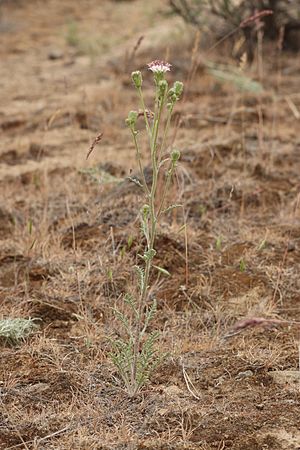Douglas' dustymaiden facts for kids
Quick facts for kids Chaenactis douglasii |
|
|---|---|
 |
|
| Scientific classification | |
| Kingdom: | |
| (unranked): | |
| (unranked): | |
| (unranked): | |
| Order: | |
| Family: | |
| Tribe: | |
| Genus: | |
| Species: |
C. douglasii
|
| Binomial name | |
| Chaenactis douglasii (Hook.) Hook. & Arn.
|
|
| Synonyms | |
|
Synonymy
Chaenactis achilleifolia Hook. & Arn.
Chaenactis angustifolia Greene Chaenactis brachiata Greene Chaenactis cheilanthoides Greene Chaenactis cinerea Stockw. Chaenactis humilis Rydb. Chaenactis imbricata Greene Chaenactis pedicularia Greene Chaenactis pumila Greene Chaenactis ramosa Stockw. Chaenactis rubricaulis Rydb. Chaenactis suksdorfii Stockw. Hymenopappus douglasii Hook. Macrocarphus achilleifolius (Hook. & Arn.) Nutt. Macrocarphus douglasii (Hook.) Nutt. |
|
Chaenactis douglasii is a cool flowering plant found in North America. People often call it Douglas' dustymaiden. It's part of the daisy family, which is a very big group of plants!
Contents
Where Does This Plant Grow?
This plant lives in many places across western Canada and the western United States. You can find it from British Columbia all the way to Saskatchewan. It also grows south into California and New Mexico. Sometimes, you might even spot it in Nebraska and the Dakotas.
Habitats Where It Thrives
Douglas' dustymaiden is super tough and can grow in many different places. It likes harsh environments, like rocky areas in high mountains such as the Sierra Nevada. You can also find it in deserts, scrublands, and even along roadsides. This plant grows at many different heights, from sea level up to about 13,000 feet (4,000 meters). It's most common between 6,000 and 8,000 feet (1,800 to 2,400 meters).
What Does Douglas' Dustymaiden Look Like?
Chaenactis douglasii is a plant that can look a bit different depending on where it grows. It's usually a perennial, meaning it lives for more than two years. It grows straight up, from about 4 to 24 inches (10 to 60 centimeters) tall. Its stems are often covered in soft, cobweb-like hairs.
Leaves and Flowers
The leaves of this plant can be up to 6 inches (15 centimeters) long. They are divided into many small parts with curled or twisted tips. The leaves higher up on the stem are smaller and don't have stalks.
The plant produces one or more flower heads. Each flower head is about 0.8 inches (2 centimeters) long. These heads are surrounded by flat, glandular leaves called phyllaries. Inside, you'll find many small, tube-shaped flowers. These flowers are usually white or pinkish and have anthers that stick out.
Seeds
After the flowers bloom, the plant produces a fruit called an achene. This achene is about 0.4 inches (1 centimeter) long. It has a special feathery top called a pappus, which helps the seeds float away in the wind.
How Was This Plant Used?
Some Plateau Indian tribes used Douglas' dustymaiden a long time ago. They would use parts of this plant to help treat burns, wounds, and sores. It was like a natural bandage or medicine for them.
Different Types of Douglas' Dustymaiden
Scientists have found a few different types, or varieties, of this plant:
- Chaenactis douglasii var. alpina
- Chaenactis douglasii var. douglasii


